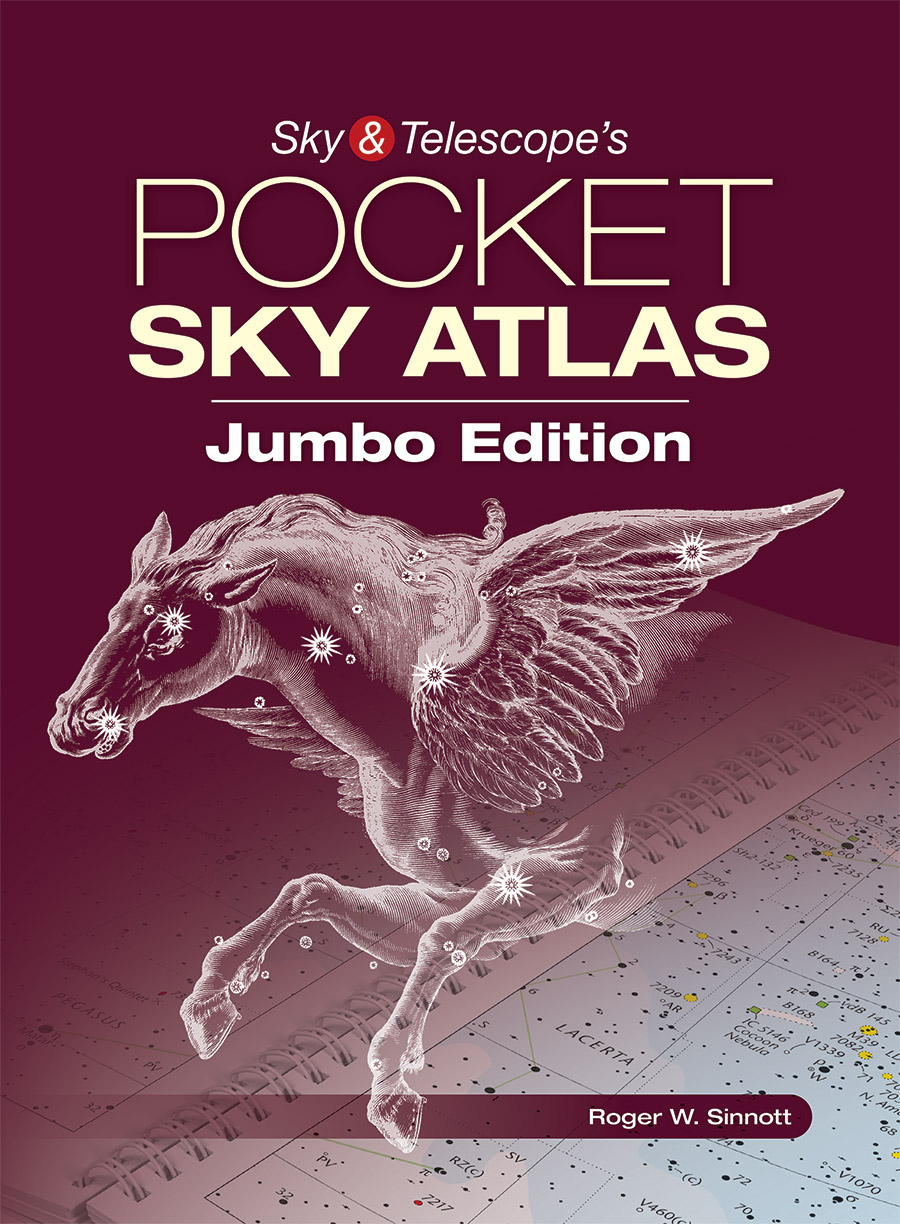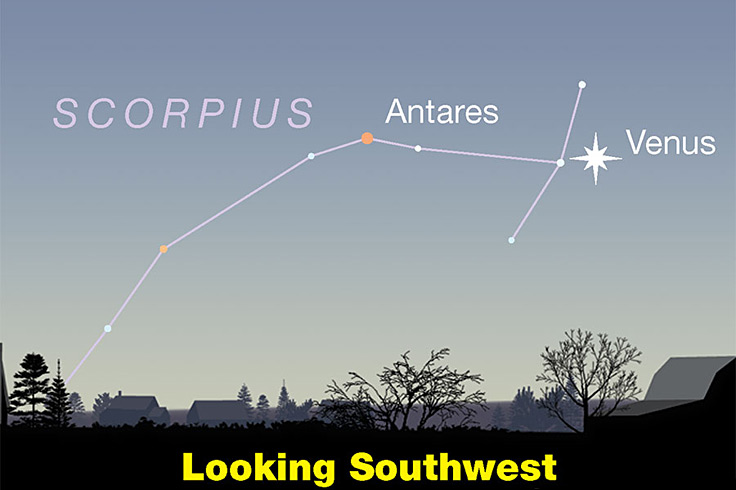Comet Tsuchinshan-ATLAS (pronounced “tzeh-chin-SHAHN”) is still in good evening view high in the west for Northern Hemisphere skywatchers, though it’s both fading and shrinking as it flies away from the Sun and Earth. Moonlight has been compromising the view; full Moon (a supermoon no less!) came on the evenings of October 16th and 17th. But on Sunday the 20th a window of dark sky begins opening between twilight’s end and moonrise. After that, the Moon will set almost an hour later each night.
See Bob King’s articles Get Ready for Comet Tsuchinshan-ATLAS — The Best Is Yet to Come! and his update Comet Tsuchinshan-ATLAS Climbs, Brightens and Delights!

Sky & Telescope graphic
FRIDAY, OCTOBER 18
■ This is the time of year when the Big Dipper lies down horizontal low in the north-northwest around 10 p.m. as evening grows late. How low? The farther south you are, the lower. Seen from 40° north (New York, Denver) even its bottom stars twinkle nearly ten degrees high at their lowest. But at Miami (26° N) the entire Dipper will skim along out of sight just below the north horizon.

Antares, 9° left of Venus, is magnitude 1.0, twice as bright as Delta Sco. Venus will pass Antares in just seven days.
SATURDAY, OCTOBER 19
■ The Moon, just past full, rises in late twilight. Once it’s well up and twilight is over, look for the Pleiades just a few degrees to its upper right. Cover the Moon with your fingertip to reduce its glary interference.
■ The Orionid meteor shower should be active in the hours before dawn Sunday morning, but don’t expect to see many at all through the waning gibbous moonlight. The radiant, in Orion’s upraised club, will be high in the southeast to south by then.
■ Even if the meteors disappoint when you’re out before dawn Sunday, you can catch Pollux, Mars, and Procyon forming a straight line, in that order from upper left to lower right. The three shine with fairly similar brightnesses: magnitudes +1.1, +0.3, and +0.4, respectively. Pollux appears three times closer to Mars than Procyon does.
Mars is moving eastward against the stars. Tomorrow morning the line won’t be quite so straight.

SUNDAY, OCTOBER 20
■ For most Northern Hemisphere observers, this is the first evening in more than a week that offers a brief window of Moon-free darkness for spotting Comet Tsuchinshan-ATLAS between twilight’s end and moonrise. The comet should be about 4th magnitude now, much faded from a week ago. But the dark sky helps make up for this, especially for time-exposure photography. And with the comet now nice and high in the southwest, it’s a great time to examine its head and nucleus at high power for changing night-to-night details. The Moon will rise nearly an hour later each night from now on.
■ After the Moon does rise tonight, watch for Jupiter to rise to its lower right 30 or 40 minutes later. They’ll accompany each other across the sky until dawn.
MONDAY, OCTOBER 21
■ Now that it’s late October, Deneb has pushed Vega toward the west and has taken its place as the zenith star during the last of twilight (for skywatchers at mid-northern latitudes).
Which always means, Capricornus has replaced Sagittarius as the zodiacal constellation holding prime position low in the south.
TUESDAY, OCTOBER 22
■ The Moon, nearly last quarter, rises around 10 or 11 tonight. Give it a while to rise higher, and it forms a nice triangle with Castor to its left and Pollux to its lower left. Farther below the Moon, Mars is coming up.
By the dawn of Wednesday the 23rd, the four of them are grouped very high in the south as shown below.

WEDNESDAY, OCTOBER 23
■ The last-quarter Moon rises around 11 or midnight tonight. Forming a gently curving arc above it are Castor, Pollux and Mars, in that order from top down. That’s also their order of increasing brightness. The arc is 10° long. By dawn on the 24th the pattern has twisted clockwise, as shown above.
THURSDAY, OCTOBER 24
■ The Ghost of Summer Suns. Halloween is approaching, and this means that Arcturus, the star sparkling low in the west-northwest in twilight, is taking on its role as “the Ghost of Summer Suns.” For several evenings centered on October 25th every year, Arcturus occupies a special place above your local landscape. It closely marks the spot where the Sun stood at the same time, by the clock, during hot June and July — in broad daylight, of course!
So, as Halloween approaches every year, you can see Arcturus as the chilly ghost of the departed summer Sun.
FRIDAY, OCTOBER 25
■ Venus is in conjunction with orange Antares low in twilight, as shown below. Venus is 100 times brighter than Antares; look for the tiny orange point 3° to Venus’s lower left. Binoculars will help you spot it through the twilight and the thick air near the horizon.

SATURDAY, OCTOBER 26
■ Spot bright Altair high in the southwest soon after dark. Brighter Vega is far to its right.
Above Altair lurk two distinctive little constellations: Delphinus the Dolphin, hardly more than a fist at arm’s length to Altair’s upper left, and smaller, fainter Sagitta the Arrow, slightly less far to Altair’s upper right. Sky too bright? Use binoculars!
SUNDAY, OCTOBER 27
■ Draw a line from Altair, the brightest star very high in the southwest after dark, to the right to Vega, very high in the west and even brighter. Continue the line onward by half as far, and you hit the Lozenge: the pointy-nosed head of Draco, the Dragon. Its brightest star is orange Eltanin, the tip of the Dragon’s nose, always pointing toward Vega.
This Week’s Planet Roundup
Mercury remains hidden deep in the sunset.
Venus, magnitude –4.0, gleams low in the southwest as evening twilight fades. It continues to set around twilight’s end.
Mars (magnitude +0.2, in eastern Gemini) rises around 11 or midnight. It shows best, very high in the south-southeast, in the hour before dawn. It’s 33° east along the ecliptic from bright Jupiter. Mars in a telescope is still a small 8½ arcseconds wide, on its way to a mediocre opposition (14.5 arcseconds) next January.
Jupiter (magnitude –2.6, still near the horntip stars of Taurus) rises in the east-northeast around 9 p.m. Like Mars, it’s highest in the hours before dawn. Jupiter is now a nice 45 arcseconds wide in a telescope, hardly smaller than the 48-arcsecond width it will attain for the weeks around its opposition in December.

Mars here shows its North Polar Cap, dark Mare Sirenum near the South Polar Cloud Hood, and some finer detail. On Jupiter, the North Equatorial Belt (with a bright white cloud outbreak) is slightly darker than the South Equatorial Belt, at least on this side of the planet.
Saturn, magnitude +0.7 in Aquarius, is well up in the southeast as the stars come out. Don’t confuse it with Fomalhaut two fists to its lower right. Saturn is highest in the south by about 10 p.m.

Uranus (magnitude 5.6, near the Taurus-Aries border) is well up by late evening about 5° from the Pleiades. You’ll need a good finder chart to identify it among its surrounding faint stars.
Neptune (tougher at magnitude 7.8, near the Circlet of Pisces) is well up after nightfall, 14° east of Saturn. Again you’ll need a proper finder chart.
All descriptions that relate to your horizon — including the words up, down, right, and left — are written for the world’s mid-northern latitudes. Descriptions and graphics that also depend on longitude (mainly Moon positions) are for North America.
Eastern Daylight Time (EDT) is Universal Time minus 4 hours. UT is also known as UTC, GMT, or Z time.
Want to become a better astronomer? Learn your way around the constellations. They’re the key to locating everything fainter and deeper to hunt with binoculars or a telescope.
This is an outdoor nature hobby. For a more detailed constellation guide covering the whole evening sky, use the big monthly map in the center of each issue of Sky & Telescope, the essential magazine of astronomy.
Once you get a telescope, to put it to good use you’ll need a much more detailed, large-scale sky atlas (set of charts). The basic standard is the Pocket Sky Atlas (in either the original or Jumbo Edition), which shows all stars to magnitude 7.6.

Next up is the larger and deeper Sky Atlas 2000.0, plotting stars to magnitude 8.5; nearly three times as many. It’s currently out of print. The next up, once you know your way around well, are the even larger Interstellarum atlas (stars to magnitude 9.5) or Uranometria 2000.0 (stars to mag 9.75). And read How to Use a Star Chart with a Telescope. It applies just as much to charts on your phone or tablet as to charts on paper.
You’ll also want a good deep-sky guidebook. A beloved old classic is the three-volume Burnham’s Celestial Handbook. An impressive more modern one is the big Night Sky Observer’s Guide set (2+ volumes) by Kepple and Sanner. The pinnacle for total astro-geeks is the Annals of the Deep Sky series, currently at 10 volumes as it slowly works forward through the constellations alphabetically. So far it’s only up to F.
Can computerized telescopes replace charts? Not for beginners I don’t think, and not for scopes on mounts and tripods that are less than top-quality mechanically. Unless, that is, you prefer spending your time getting finicky technology to work rather than learning how to explore the sky. As Terence Dickinson and Alan Dyer say in their Backyard Astronomer’s Guide, “A full appreciation of the universe cannot come without developing the skills to find things in the sky and understanding how the sky works. This knowledge comes only by spending time under the stars with star maps in hand and a curious mind.” Without these, “the sky never becomes a friendly place.”
If you do get a computerized scope, make sure that its drives can be disengaged so you can swing it around and point it readily by hand when you want to, rather than only slowly by the electric motors (which eat batteries).
However, finding faint telescopic objects the old-fashioned way with charts isn’t simple either. Learn the essential tricks at How to Use a Star Chart with a Telescope.
![]() Audio sky tour. Out under the evening sky with your
Audio sky tour. Out under the evening sky with your
earbuds in place, listen to Kelly Beatty’s monthly
podcast tour of the naked-eye heavens above. It’s free.
“The dangers of not thinking clearly are much greater now than ever before. It’s not that there’s something new in our way of thinking, it’s that credulous and confused thinking can be much more lethal in ways it was never before.”
— Carl Sagan, 1996
“Facts are stubborn things.”
— John Adams, 1770

